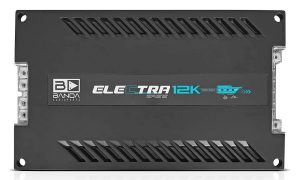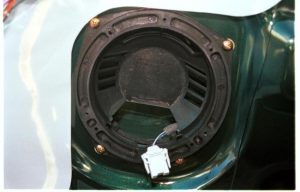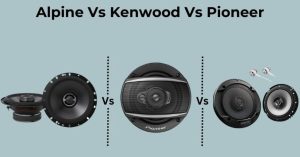Car audio enthusiasts know the thrill of crisp, booming bass that transforms every drive into a concert-like experience. A rear deck subwoofer box offers a practical, space-efficient way to achieve that deep, resonant sound without sacrificing trunk space. This setup not only enhances your music but also elevates the overall driving experience. Let’s dive into why a rear deck subwoofer box is a game-changer, how to choose the right one, and tips for installation and optimization to ensure your car audio system hits all the right notes.
Contents
- Why Choose a Rear Deck Subwoofer Box?
- Key Features of a Rear Deck Subwoofer Box
- Benefits of Installing a Rear Deck Subwoofer Box
- How to Choose the Best Rear Deck Subwoofer Box
- Installation Tips for a Rear Deck Subwoofer Box
- Optimizing Your Rear Deck Subwoofer for Maximum Performance
- Common Mistakes to Avoid
- Top Rear Deck Subwoofer Boxes to Consider
- Why Rear Deck Subwoofers Are a Must-Have for Audio Enthusiasts
Why Choose a Rear Deck Subwoofer Box?
A rear deck subwoofer box sits in the rear shelf of your vehicle, typically behind the back seats. This placement maximizes bass output while keeping your trunk free for groceries, sports gear, or road trip essentials. Unlike traditional trunk-mounted subwoofers, rear deck setups integrate seamlessly into your car’s interior, delivering powerful low-frequency sound directly into the cabin.
This design offers several benefits. First, it saves space. If you drive a compact car or need trunk room for daily use, a rear deck subwoofer fits perfectly. Second, it improves sound distribution. By positioning the subwoofer closer to the passengers, the bass feels more immediate and immersive. Finally, rear deck boxes often blend with your car’s aesthetics, maintaining a clean, factory-like look.
For anyone craving heart-pounding bass without cluttering their vehicle, this setup strikes the perfect balance between performance and practicality.
Key Features of a Rear Deck Subwoofer Box
Selecting the right rear deck subwoofer box requires understanding its core components. Here’s what to look for:
1. Subwoofer Size
Subwoofers come in various sizes, typically ranging from 8 to 12 inches for rear deck applications. Smaller 8-inch subwoofers produce tight, punchy bass, ideal for genres like rock or pop. Larger 10- or 12-inch models deliver deeper, more powerful lows, perfect for hip-hop or electronic music. Consider your music preferences and the available space on your rear deck when choosing.
2. Enclosure Type
The box’s enclosure significantly impacts sound quality. Sealed enclosures offer accurate, controlled bass, making them great for detailed audio reproduction. Ported enclosures, on the other hand, amplify low frequencies, creating louder, booming bass. Your choice depends on whether you prioritize precision or raw power.
3. Power Handling
Check the subwoofer’s power rating, measured in watts RMS (Root Mean Square). This indicates how much power the subwoofer can handle continuously. Match the subwoofer’s RMS rating to your amplifier’s output for optimal performance. A mismatch can lead to distorted sound or even damage to the subwoofer.
4. Build Quality
A sturdy, well-constructed box minimizes vibrations and rattling, ensuring clean sound. Look for enclosures made from high-quality materials like MDF (medium-density fiberboard) with secure mounting options. Carpeting or upholstery that matches your car’s interior adds a polished touch.
5. Compatibility
Ensure the subwoofer box fits your vehicle’s rear deck dimensions. Measure the available space and check the manufacturer’s specifications. Some boxes are designed for specific car models, offering a custom fit for hassle-free installation.
By focusing on these features, you’ll find a rear deck subwoofer box that delivers the sound quality and practicality you need.
Benefits of Installing a Rear Deck Subwoofer Box
Adding a rear deck subwoofer box to your car audio system unlocks a range of advantages. Here’s why this upgrade is worth considering:
- Enhanced Bass Response: The rear deck’s proximity to the cabin amplifies low frequencies, creating a richer, more immersive listening experience.
- Space Efficiency: Unlike bulky trunk subwoofers, rear deck boxes preserve cargo space, making them ideal for smaller vehicles or daily drivers.
- Improved Aesthetics: A well-designed box blends with your car’s interior, avoiding the cluttered look of exposed trunk setups.
- Versatile Sound Customization: Pair the subwoofer with an amplifier and equalizer to fine-tune the bass to your liking, whether you prefer subtle lows or earth-shaking thumps.
- Increased Resale Value: A high-quality audio system can boost your car’s appeal to future buyers, especially audio enthusiasts.
These benefits make the rear deck subwoofer box a smart investment for anyone looking to upgrade their car audio without compromising space or style.
How to Choose the Best Rear Deck Subwoofer Box
With countless options on the market, picking the perfect rear deck subwoofer box can feel overwhelming. Follow these steps to narrow down your choices:
1. Assess Your Music Preferences
Your favorite genres influence the type of subwoofer you need. For example, jazz and classical listeners may prefer a sealed enclosure for crisp, accurate bass. Fans of rap or EDM might opt for a ported box to maximize low-end power.
2. Check Vehicle Compatibility
Measure your rear deck’s dimensions and confirm the box fits. Some manufacturers offer vehicle-specific models for brands like Honda, Toyota, or Ford, ensuring a snug, secure fit.
3. Set a Budget
Rear deck subwoofer boxes range from $100 to over $500, depending on size, brand, and features. Decide how much you’re willing to spend, factoring in additional costs like an amplifier or wiring kit.
4. Research Trusted Brands
Stick to reputable brands like JL Audio, Rockford Fosgate, or Kicker, known for their durability and sound quality. Read customer reviews to gauge real-world performance.
5. Consider Installation Requirements
Some boxes come pre-loaded with subwoofers, simplifying setup. Others require separate purchases and assembly. If you’re not comfortable with DIY installation, plan to hire a professional.
By aligning your choice with your needs and vehicle, you’ll find a subwoofer box that delivers exceptional sound and value.
Installation Tips for a Rear Deck Subwoofer Box
Installing a rear deck subwoofer box requires careful planning to achieve optimal sound and safety. Here’s a step-by-step guide:
1. Gather Tools and Materials
You’ll need a screwdriver, wire cutters, a wiring kit, an amplifier, and mounting hardware. A sound-deadening mat can reduce vibrations and improve audio clarity.
2. Prepare the Rear Deck
Remove any panels or carpeting from the rear deck to access the mounting area. Check for structural reinforcements to ensure the deck can support the subwoofer’s weight.
3. Secure the Subwoofer Box
Place the box on the rear deck and mark the mounting points. Drill holes if necessary, then secure the box with bolts or screws. Ensure it’s firmly attached to prevent movement while driving.
4. Connect the Wiring
Run power and signal cables from the amplifier to the subwoofer. Use a wiring kit with proper gauge cables to handle the power load. Keep wires organized and away from moving parts like seat mechanisms.
5. Test the System
Turn on your car’s audio system and play music to test the subwoofer. Adjust the amplifier’s gain and crossover settings to balance the bass with your other speakers. Listen for rattles or distortions and address them promptly.
6. Add Sound Deadening
Apply sound-deadening material to the rear deck and surrounding panels to minimize vibrations and enhance bass clarity.
If you’re new to car audio installation, consider consulting a professional to avoid damaging your vehicle or equipment. A proper setup ensures years of high-quality sound.
Optimizing Your Rear Deck Subwoofer for Maximum Performance
Once installed, fine-tuning your rear deck subwoofer box unlocks its full potential. Try these tips to optimize performance:
- Adjust Amplifier Settings: Set the low-pass filter to ensure the subwoofer only handles bass frequencies, typically below 80 Hz. Tweak the gain to avoid clipping or distortion.
- Balance the Soundstage: Use your head unit’s equalizer to blend the subwoofer’s output with your midrange and tweeter speakers. This creates a cohesive, balanced sound.
- Experiment with Placement: If your rear deck allows, test different subwoofer positions to find the sweet spot for bass response. Even slight adjustments can make a difference.
- Upgrade Supporting Components: A high-quality amplifier and wiring kit improve power delivery, enhancing the subwoofer’s performance.
- Regular Maintenance: Check the subwoofer and box periodically for loose connections or wear. Clean the enclosure to maintain its appearance.
By dialing in these settings, you’ll enjoy crisp, powerful bass that elevates every song.
Common Mistakes to Avoid
Even seasoned audio enthusiasts can make missteps when installing a rear deck subwoofer box. Steer clear of these pitfalls:
- Choosing the Wrong Size: A subwoofer too large for your rear deck can overwhelm the space and cause vibrations. Measure carefully before buying.
- Skimping on Power: Pairing a high-powered subwoofer with a weak amplifier leads to underwhelming sound. Match components for optimal results.
- Ignoring Sound Deadening: Skipping sound-deadening materials results in rattles and muddy bass. Invest in quality mats for a cleaner sound.
- Improper Wiring: Using low-quality or undersized cables can cause power loss or electrical issues. Choose a reliable wiring kit.
- Overlooking Vehicle Compatibility: Not all rear decks support subwoofer boxes. Verify your car’s suitability to avoid installation headaches.
Avoiding these errors ensures a smooth installation and top-notch audio performance.
Top Rear Deck Subwoofer Boxes to Consider
To help you start your search, here are three highly rated rear deck subwoofer boxes:
- JL Audio CP108LG-W3v3
- Size: 8-inch subwoofer
- Enclosure: Ported
- Power Handling: 250 watts RMS
- Why It Stands Out: Compact design with deep, powerful bass. Ideal for small to midsize vehicles.
- Rockford Fosgate P300-10
- Size: 10-inch subwoofer
- Enclosure: Sealed
- Power Handling: 300 watts RMS
- Why It Stands Out: Built-in amplifier simplifies installation. Delivers tight, accurate bass.
- Kicker CompRT 43CWRT672
- Size: 6.75-inch subwoofer
- Enclosure: Sealed
- Power Handling: 150 watts RMS
- Why It Stands Out: Ultra-slim design fits tight spaces. Perfect for compact cars.
These models offer a range of sizes and features to suit different vehicles and budgets. Always check compatibility with your car before purchasing.
Why Rear Deck Subwoofers Are a Must-Have for Audio Enthusiasts
A rear deck subwoofer box transforms your car into a mobile soundstage, delivering bass that you can feel as much as hear. Its space-saving design, seamless integration, and customizable sound make it a top choice for drivers who refuse to compromise on audio quality. Whether you’re cruising through the city or embarking on a cross-country road trip, the right subwoofer box ensures every song sounds its best.
Ready to elevate your car audio? Start by measuring your rear deck, setting a budget, and exploring trusted brands. With the right rear deck subwoofer box, you’ll turn every drive into an unforgettable listening experience.






